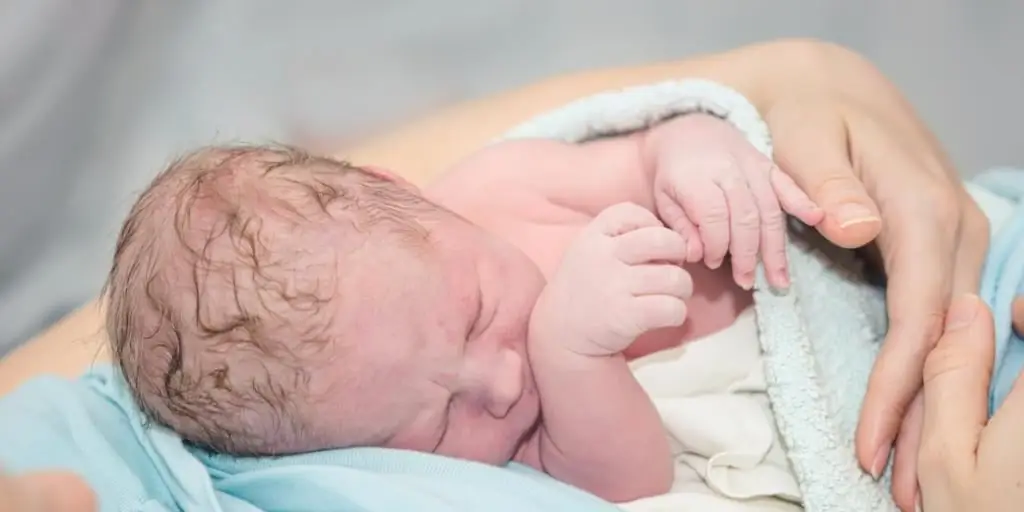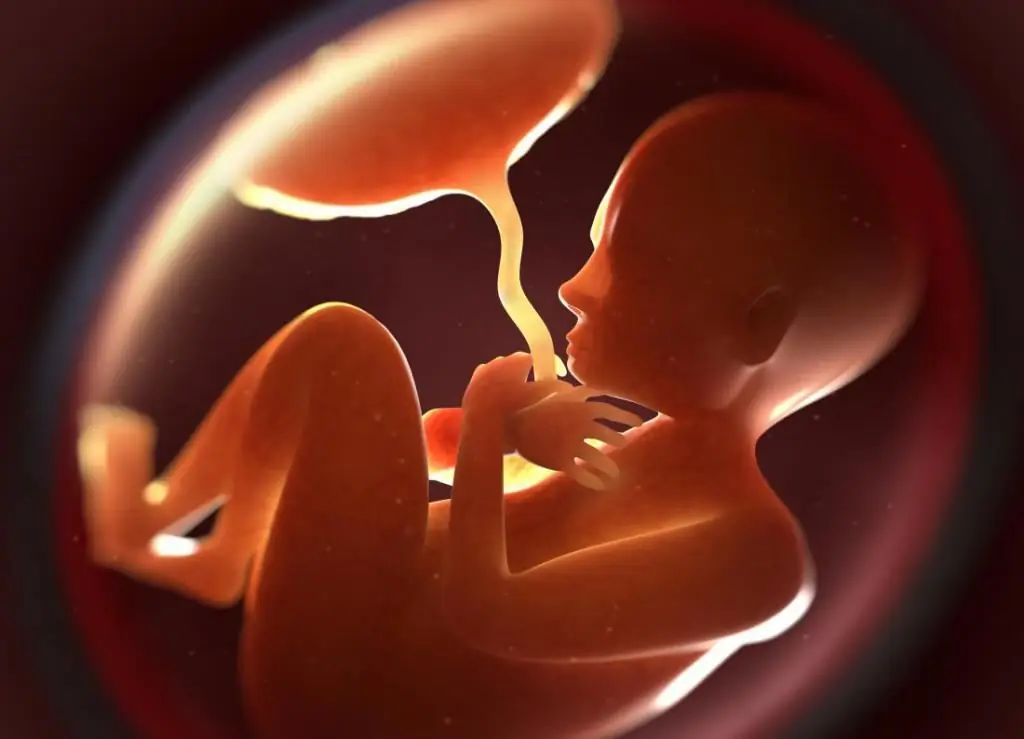2025 Author: Priscilla Miln | [email protected]. Last modified: 2025-01-22 17:55:27
The marginal attachment of the umbilical cord to the placenta is a relatively rare reason for the experiences of the expectant mother. However, such an anomaly of fixation of the umbilical cord in some cases (especially if complicated by other problems) can cause heavy bleeding during childbirth and death of the fetus. To reduce risks, a pregnant woman may be advised to have a caesarean delivery.

Pregnancy monitoring
The key to successful childbearing is regular monitoring in the antenatal clinic. At the required time, the doctor will refer the pregnant woman for tests and other diagnostic procedures, conduct additional studies if indicated or if pathology is suspected.
Among the many possible complications of gestation, anomalies in the attachment of the umbilical cord to the placenta stand out. In the early stages, such pathologies are not detected, but in the later stages they can affect the tactics of childbirth or worsen the condition of the child.

Diagnosis of attachment anomalies is usually carried out in the second trimester of pregnancy, provided that the placenta is located on the anterior or lateral walls of the uterus, although the umbilical cord can be examined at an earlier date. If the placenta is located on the back wall or the woman has oligohydramnios, then the diagnosis of anomalies in the attachment of the umbilical cord is difficult. The main diagnostic procedure is ultrasound diagnostics. Ultrasound is performed as part of the first and second screenings, in the third trimester of pregnancy, and also when indicated.
What is pregnancy screening? This is a set of studies that are conducted to identify a group of pregnant women with possible fetal malformations. Screening includes a biochemical blood test and ultrasound. These are fairly proven and reliable diagnostic methods, however, the need for screening still causes a lot of controversy (mainly among expectant mothers themselves).
Umbilical cord attachment
The umbilical cord, or umbilical cord, is a "cord" of three vessels: two arteries and one vein. Veins supply the fetus with blood enriched with oxygen and nutrients, while arteries carry blood that carries carbon dioxide. After birth, the umbilical cord from the side of the child is clamped with a clamp and cut off, and a process and an umbilical wound remain in its place. The appendix falls off withinfour to five days, and the wound gradually heals.

How does the umbilical cord attach to the placenta on the mother's side? In nine out of ten pregnancies, the cord is attached to the middle of the placenta. This is considered the norm. The detachment of the umbilical cord from the center of the child's place is considered as a feature of fixation. Anomalies of attachment include sheath, lateral and marginal attachment of the umbilical cord to the placenta.
Attachment anomalies
Shell attachment is characterized by attachment not to the placental tissue, but to the membrane. In this case, the vessels in some area are not protected, which creates a risk of damage and bleeding when the membranes are ruptured. In addition to the danger of heavy bleeding during childbirth, some doctors argue that such a pathology increases the risk of intrauterine growth retardation.
Such a complication occurs only in 1.1% of singleton pregnancies, and in twins and triplets it occurs more often - in 8.7% of cases. The anomaly may be accompanied by fetal malformations in 6-9% of cases, especially defects in the atrial and interventricular septa of the heart, artresia of the esophagus, and congenital uropathy. It happens that there is only one artery in the umbilical cord or there are additional lobes of the placenta. Sheath attachment has been described in trisomy 21 (Down's syndrome) in the fetus.

Doctors can suspect dangerous diagnoses at routine screening of the first and second trimesters, which are carried out respectively at 11-13 weeks, at 18-21weeks, as well as on an ultrasound of the third trimester (what screening during pregnancy is described above).
In case of an increased risk, a woman is recommended additional methods for diagnosing pathologies: puncture of the umbilical cord (cordocentesis), electro- and phonocardiography of the fetus, cardiotocography of the fetus, dopplerography, biophysical profile, amnioscopy (study of the state of the amniotic fluid and fetus), aminocentesis (puncture of the amniotic liquid) and so on.
Umbilical Cord Marginal Attachment
The umbilical cord can be attached to the placenta from the side, closer to the edge. So, fixation is noted not in the central zone, but in the peripheral one. Arteries and vein enter too close to the very edge. Usually, such an anomaly does not threaten the normal course of pregnancy and childbirth. Marginal attachment is considered a feature of a particular period of gestation.
If the marginal attachment of the umbilical cord to the placenta is diagnosed, what should I do? Gynecologists say that such a pathology does not threaten the development of the fetus and the normal course of pregnancy, and is also not an indication for caesarean section, that is, natural delivery is performed. The only important feature: when medical personnel try to separate the placenta in the third stage of labor by pulling on the umbilical cord, the umbilical cord may be torn off, which threatens to bleed and requires manual removal of the placenta from the uterine cavity.

Reasons for this condition
The marginal attachment of the umbilical cord in the placenta occurs as a result of a primary defect in the implantation of the umbilicalstrand when it is localized in the area that forms the child's place. Risk factors include:
- mother's age under 25;
- excessive exercise;
- first pregnancy;
- certain obstetric factors (polyhydramnios or oligohydramnios, fetal position or presentation, weight).
Often, abnormal attachment is accompanied by other variants of pathology - non-spiral arrangement of nodes, true nodes.
Danger of diagnosis
What threatens the marginal attachment of the umbilical cord to the placenta? Such an anomaly, in most cases, is not a serious condition. Doctors pay special attention to localization if the umbilical cord is too short or too long, because this creates an additional risk of various obstetric complications. In addition, it is important how close to the edge the cord is attached. If too close, then there is a risk of oxygen starvation. Usually, with such a diagnosis, CTG is performed twice a week for the entire period of pregnancy in order to determine the possible fetal malaise in time.
How is the pregnancy going
The marginal attachment of the umbilical cord to the placenta is rarely accompanied by complications. In a small number of cases, there is a risk of intrauterine fetal hypoxia, developmental delay, and premature birth. Shell attachment is much more dangerous. In this case, damage to the vessels of the umbilical cord during pregnancy is possible. This is accompanied by the release of blood from the mother's genital tract, fetal heart palpitations, followed by a decrease in frequency, muffled heart sounds and other manifestations.lack of oxygen in the child.

Features of childbirth
With marginal attachment during childbirth, damage to blood vessels is possible, followed by bleeding, which poses a danger to the life of the child. To prevent complications during delivery, timely recognition of the exit of the umbilical cord is necessary. Childbirth should be gentle and fast, the fetal bladder should be opened in a place that will be remote from the vascular zone. A doctor can allow a woman to have a natural childbirth, but this requires good skills of medical personnel, as well as constant monitoring of the condition of the mother and child.
If during childbirth a rupture of blood vessels occurs, then the child is turned on the leg and removed. If the fetal head is already in the cavity or at the exit from the pelvis, then obstetric forceps are applied. These methods can be applied if the child is alive.
Often (and especially if there are additional medical indications), doctors recommend a planned caesarean section for a woman with a marginal attachment of the umbilical cord to the placenta. The operation avoids the negative consequences that may occur in natural childbirth.
Feature removal
Expectant mothers are interested not only in what is the marginal attachment of the umbilical cord, but in ways to eliminate this feature so that there are fewer risks in childbirth. But during pregnancy, it is impossible to eliminate the anomaly. There is no medical or surgical treatment. No amount of exercise will fix the wrongattachment of the cord between mother and fetus. The main purpose of observation is to prevent rupture of the membranes of blood vessels and the subsequent death of the child in childbirth.

Short conclusion
A certain number of pregnancies are complicated by various pathologies of the umbilical cord or placenta, one of which includes attachment anomalies. Many of these anomalies do not affect the gestation period and childbirth, but in some cases there is a serious threat to the he alth and life of the mother or child. The doctor can detect pathology during a routine ultrasound examination. Based on the data obtained, the most appropriate method of delivery is selected. The expectant mother needs to try to be less nervous. It is imperative to trust specialists who will help you carry and give birth to a child.
Recommended:
The placenta covers the internal os - what to do? How to raise the placenta during pregnancy

The period of pregnancy is associated with future mothers with great joy and great anxiety for the he alth of their crumbs. These feelings are quite natural and accompany a woman for all nine months. At the same time, even if there is no reason to worry, the pregnant woman will be worried and constantly listen to her feelings. And if doctors noticed some deviations from the norm during a routine examination, it is difficult for a woman to calm down
Cutting the umbilical cord: cutting technique and clamping, timing

The birth of a child is an exciting and responsible process not only for parents, but also for the baby. If possible, it should proceed naturally and as easily as possible - the state of he alth of both depends on this. And now the newborn is on the mother's stomach, and after a while the doctors proceed to another mandatory procedure - cutting the umbilical cord. But does everyone understand exactly when this should happen? Meanwhile, the condition of the child largely depends on this
Processing the umbilical cord of a newborn at home

Immediately after birth, the baby's umbilical cord is cut. For some time in this area there is a wound that requires the care that a newborn needs. Processing of the umbilical cord is carried out at home and requires the use of pharmacy products and knowledge of the correct algorithm of actions
Short umbilical cord: causes, consequences for the child and mother

Doctors call the umbilical cord the umbilical cord. It connects a small embryo, which later becomes a fetus, to the placenta. With the help of such a kind of "bridge" the child's body is connected with the mother throughout the entire period of pregnancy. Communication is maintained until the very birth. There are norms for the length of the strand, but in some cases it can be longer or shorter. Both a short umbilical cord and a long one can lead to negative consequences
What threatens poor blood clotting during pregnancy?

Waiting for a baby is the most important time in every woman's life. It is associated with significant changes in the body of the expectant mother. It is especially important during this period to observe the daily regimen, monitor the diet and monitor your condition by undergoing systematic examinations. The expectant mother may face such a problem as poor blood clotting during pregnancy

